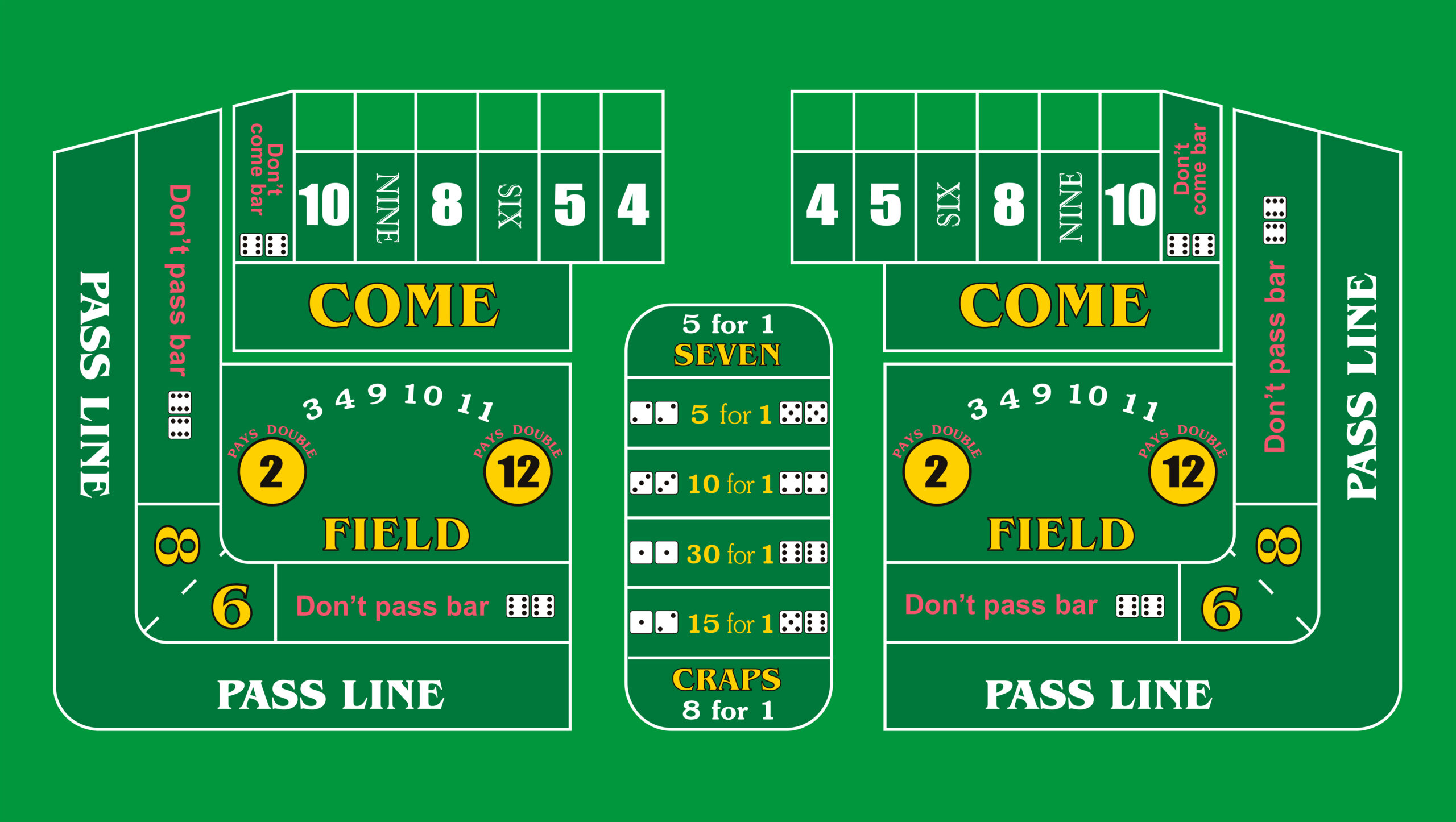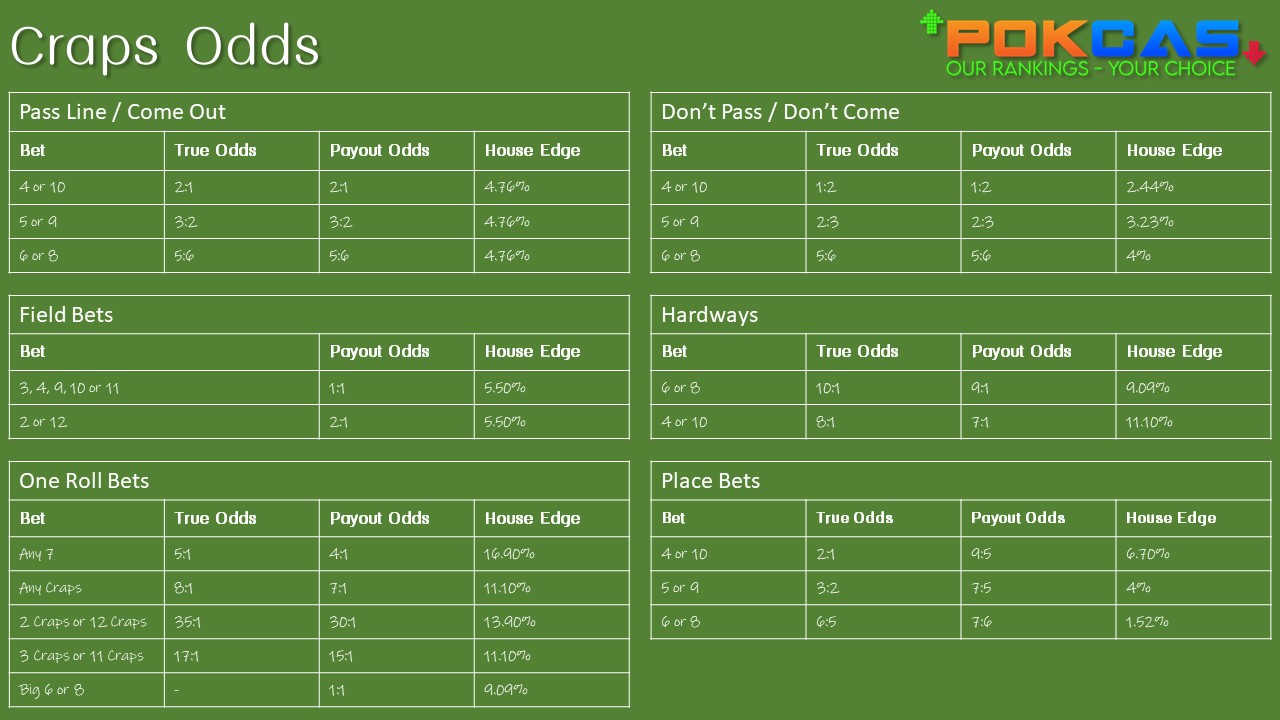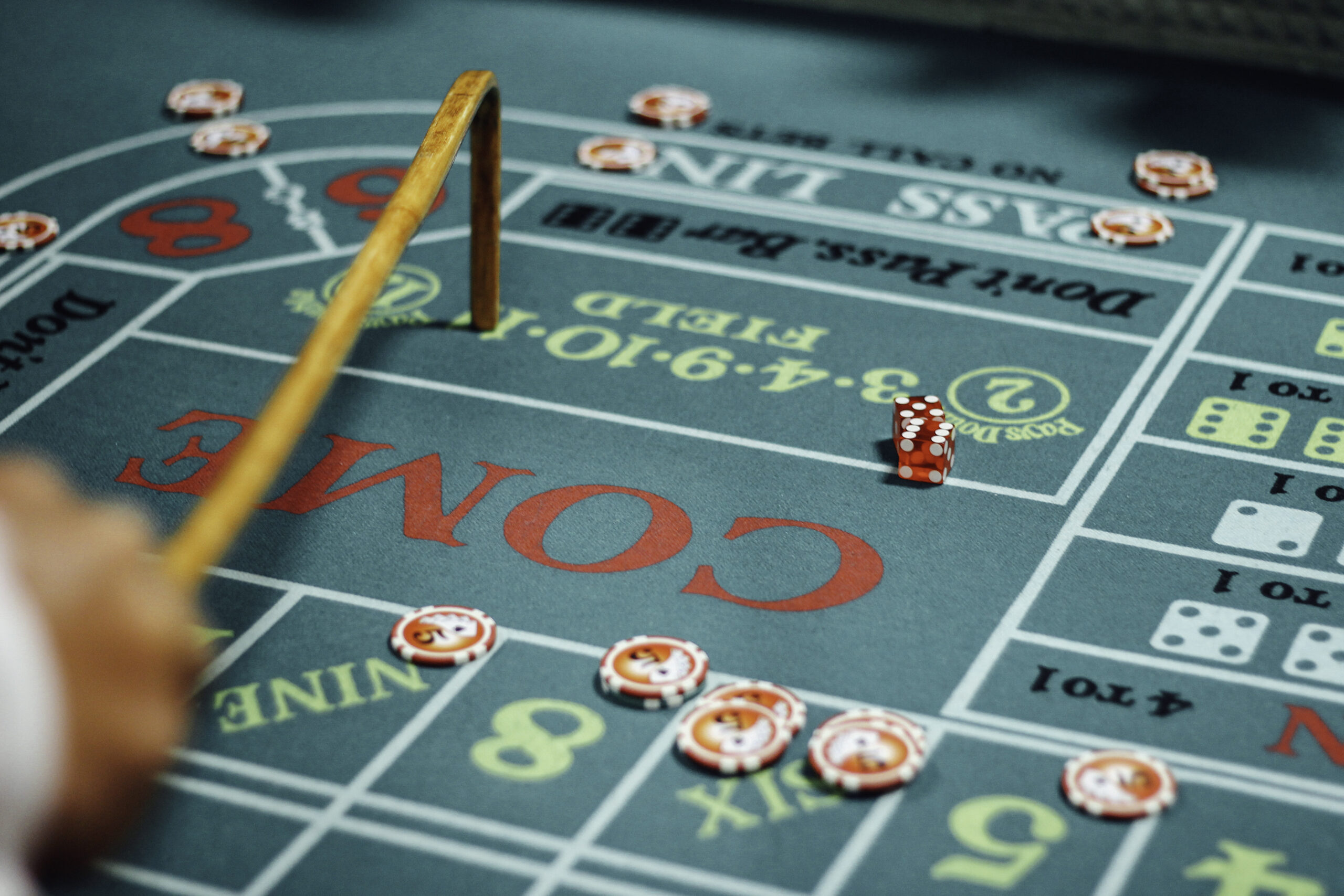How to Play Craps? Strategy and Odds

There are so many different sorts of games available to play at both land-based and online casinos. While all of them have an element of risk to them, some are completely chance based, while others are skill-based. Slots are a classic example of those that rely purely on chance (you have no say in the outcome), while poker and blackjack rely on skill and chance, together.
Then there are those games, like roulette and craps, which have chance-based outcomes, but the odds can be controlled by the different types of bets you place. These games meet the equilibrium and are extremely popular around the world.
Craps is an American invention. It is a game where the outcome is determined by the roll of two dice by one of the players at the table. There are numerous betting options on the table and craps strategy relies on you understanding what each bet means. While the game may seem confusing at first, once you get the hang of the basic rules, you’ll soon find your confidence.
Where to Play Craps online for real money
There is no shortage of places to practice your craps strategy. If there is no retail casino near you, there are multiple online casinos that are more than willing to offer entertainment via your desktop or mobile phone.
- BetOnline – Sign up here
- Bovada – Sign up here
- BetUS – Sign up here
- XBet – Sign up here
The Basics of Play
Craps is a multiplayer game involving several players and at least four dealers (land-based casinos only). Each round, another player (rotates clockwise) gets the chance to be the shooter. This is the player who actually throws the dice to determine the outcome. While the shooter throws the dice, all other players at the table may still lodge bets on the craps board in accordance with how they think the throw will go.
Here are some terms to memorize when it comes to the individuals involved at the table:
| Person Involved | Description |
|---|---|
| Shooter | The player throwing the dice. |
| Player | Those betting on the throw of the shooter. |
| Boxman | The lead official overseeing the table. |
| Stickman | The official that controls the retrieval of the dice. He uses his stick (also called a mop or whip) to control the dice. |
| 2 Dealers on Base | There is one dealer on either side of the table. They keep track of your bets, pay you if you win, and remove your chips if you lose. They will also place certain bets for you. |
Please note that if you are playing online craps at a virtual table, everything is handled by the computer. Live casinos online operate in a similar fashion to the land-based version of the game, but the shooting is obviously not undertaken by a real player.
Craps Boards – So intimidating
When you approach craps tables/craps boards, it may seem a little overwhelming. Just a glance at the table format below is enough to confuse any newbie, as there are so many sections and numbers.
Well, you should actually just concentrate on one half of the table, as the left is just a mirror image of the right. The reason the casino does this, is because the craps tables can get really crowded. This way, players on the left and right don’t need to stretch to place their chips. They can concentrate on their craps strategy rather than fighting to get their bets in on the right option.
The Aim of the Game – Craps Basic Strategy
Anyone can pull up and place a bet at a craps table by knowing the basic premise of the game. Yes, there are other more involved betting options and craps betting strategies, but we’ll get into those a little later.
When you pull up up a seat, look for the “Puck”. This is a flat round token on the table. If it is placed in the “off” position, the round is yet to start. Players can now place their bets on either the Pass Line or Don’t Pass Line/Bar. Once all bets are in, the shooter will throw his/her come out roll. Here’s what happens based on the wager you chose:
Pass Line:
- If the shooter rolls a 7 or 11, all Pass Line bets will receive an even odds win right away.
- If the shooter throws a 2, 3, or 12 (known as CRAPS), any Pass Line bets lose.
- If the shooter throws any other number (4, 5, 6, 8, 9, 10), that rolls becomes the ‘point‘.
- The Puck will move to the number representing ‘the point‘ on the table header and will be placed in the ‘on’ position.
- The shooter must now attempt to throw that same number again (as many chances as he/she needs) before they throw a 7.
- If they throw a 7 first, all Pass Line wagers lose.
- If they manage to equal their come out throw, all wagers on the pass line will win and receive a payout at even odds.
Don’t Pass Line:
- If you picked the Don’t Pass Line craps bet option, you basically play against the shooter. The outcome is opposite to that of the pass line.
- If the shooter rolls a 7 or 11, you lose right away.
- If the shooter rolls a 2 or 3, you win and are paid even odds. If they roll a 12, it’s a push/tie.
- If any other number is rolled, the ‘point’ is established.
- If the player rolls a 7 before matching the ‘point’, you will win (at even odds). If they match their come out roll, you will lose.
Those are the two basic forms of gameplay when employing simple craps strategy. There are, however, several other bets you can play as the game progresses.
Other Craps Bets
If you want to extend your gameplay and get in on some different odds, there are some other plays available to you. The odds vary based on the risk involved with each option.
Come Bets
These employ the same rules as Pass Line Bets but are played after the shooter makes a ‘point’.
- Your bet is placed in the ‘Come’ area.
- If the shooter throws a 7 or 11, you win.
- If the shooter throws a 2, 3, or 12, you lose.
- If they throw any other number, it becomes your ‘come point‘ and your wager will travel to that number box.
- If the shooter manages to throw your ‘come point‘ before throwing a 7, you will win. If they throw 7 first, you lose.
Don’t Come Bets
This craps bet employs the same rules as the Don’t Pass Line but can only be played after the shooter makes the ‘point’.
- Your bet is placed in the ‘Don’t Come’ area.
- If the shooter throws a 7 or 11, you lose.
- If the shooter throws a 2 or 3, you win (12 is a tie).
- If they throw any other number, it becomes your ‘come point’.
- If the shooter manages to throw your ‘come point’ you lose, if they throw a 7, you win.
Place Bets
This type of craps bet involves selecting any number after the shooter has established a point. If the shooter rolls that number before throwing a 7, you will win. The craps payout depends on the number you choose. Reference our odds chart for details.
Field Bets
This is a bet on the single roll of the dice at any time in the round. You win if the next roll is a 2, 3, 4, 9, 10, 11, or 12. If the shooter throws a 5, 6, 7, or 8, you lose. The craps payout differs between 1:1 and 2:1, based on the number that is rolled. See the odds chart for details.
Big 6 or Big 8
You’ll notice the Big 6 and 8 marked on the craps board. These two numbers are singled out as they are thrown more than any other number on the table, except for 7. So, if you place your bet on the Big 8, you’ll want the shooter to roll an 8 before he/she rolls a 7.
Proposition Bets
Simply look to the middle of the table to place this craps bet. As far as craps strategy is concerned, this type of bet is on the riskier side, but they do pay well. You can place a bet that the next roll will reveal one of the following:
| Craps Bets | Craps Odds |
|---|---|
| Any Craps (2, 3, or12) | Will pay 8:1 |
| 2 or 12 | Will Pay 31:1 |
| 3 or 11 | Will Pay 16:1 |
| Seven | Will pay 5:1 |
Hardaways
Here, you bet that the shooter will throw a specific pair before a 7 is rolled or before “the easy way” is rolled. You’ll need a working example for this to make sense:
- If you choose to bet on a hard 6, you will need to land a 3, 3 dice roll to win.
- If you land 6 by any other means (4, 2 or 5, 1, etc) it is considered the “easy way” and you lose.
- If a 7 is rolled before the hard 6, you lose.
You have four selections of Hardaways to choose from:
| Craps Bets | Craps Odds |
|---|---|
| Hard Four | Pays 8:1 |
| Hard Six | Pays 10:1 |
| Hard 8 | Pays 10:1 |
| Hard 10 | Pays 8:1 |
Hop Bets
Here, you get to bet on the specific combination the dice falls on in the next throw. You’ll literally have to guess the number reflected on each dice. The payout ranges between 16:1 and 31:1, depending on the combo you choose.
Craps Odds and Payouts
There are so many different combinations that dice can fall on. The odds on different combinations vary a bit according to standard craps rules. If you are wondering what any of the craps bets we mentioned above will payout, or you’d simply like to know the house edge involved in each, explore our craps odds chart below for the finer details.
Craps Strategy – Betting with Intention
When it comes to craps strategy, there is absolutely no way of guaranteeing a win against the house. Dice throws are random, which means you haven’t a way of telling what will land next. So, instead of studying hard craps strategy, rather learn some valuable betting strategy instead. Below are three popular options employed by regular players around the world.
1. The 6/8 Strategy
We’ve already shared that 6 and 8 are statistically thrown more than any other number, aside from 7. As such, some players make the Big 6 and Big 8 their favorite part of the table.
The first round they will place a bet. If it wins, they will take the profits and leave the bet on the craps board. If the bet loses, they will keep the bet on the craps board and add to it, so that if they win, they cover their losses. This is a progressive craps strategy that very rarely streaks. As such, be sure to switch from this play every now and then.
2. Craps Odds Strategy
Some players choose to bet against the shooter and the other players. This is called “Laying the Odds”. It includes making Don’t Pass Line bets and, more importantly, Don’t Come wagers. Unfortunately, the payouts are not that high on these bets, but the chances of winning are quite decent.
3. The Iron Cross
The Iron Cross craps strategy is an advanced one that is usually used by veteran players. It’s also a great craps strategy for those wanting frequent wins. The point of the play is to effectively bet on all other numbers except 7.
Place a bet on 5 and place the same value on the field. Then increase the bet by 10% and place it on 6 and the same amount on 8. You have now essentially covered the craps board and will claim a win if 7 does not land.
This betting strategy has erroneously been labeled the bet with the lowest house edge. It isn’t though. That title would go to betting on Big 6 or 8. Nevertheless, it will provide you with frequent wins, when 7 doesn’t get in your way.
Craps Strategy Round-Up
When it comes to Craps strategies, there are many out there, but none are guaranteed winners. Keeping to the simpler bets and playing the most straightforward game are the best options when you are starting out. Do not hit the craps boards with something to prove. Rather settle in and start deploying the strategies once you are more confident with the passage of play.
Craps FAQs
Why is the game called craps?
It is believed that the word CRAPS derives from the French word CRAPAUD, which means toad. It alludes to the way people used to crouch over the floor or street to play the original version of the game.
When and where was craps invented?
It is most commonly accepted that Craps derives from an earlier game called Hazard, which was invented by Sir William of Tyre during the Crusades in 1125 AD.
What is the longest craps roll ever?
In May 2009, a lady by the name of Patricia Demaro reportedly rolled the dice 154 times in 4 hours and 18 minutes before ending the round.
What other dice games are similar to craps?
The dice game most similar to Craps is Sic Bo. You also need to bet on the outcome of the dice. Sic Bo is, however, played with 3 dice and not 2 and you only get one chance to bet.







